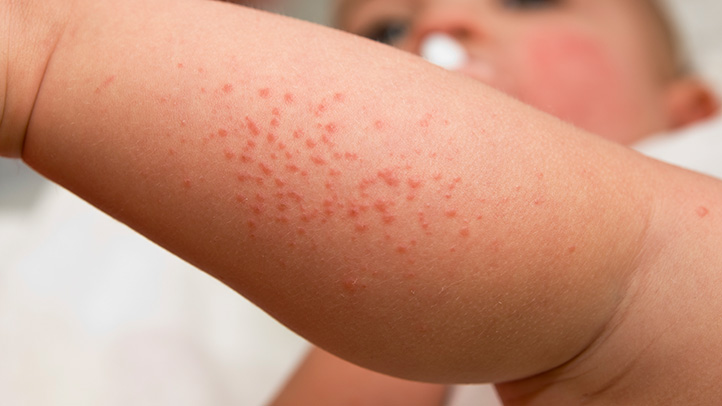Physical Address
304 North Cardinal St.
Dorchester Center, MA 02124
Physical Address
304 North Cardinal St.
Dorchester Center, MA 02124

Contents
A heat rash, also known as prickly heat or sweat rash, is a common skin condition that occurs when sweat ducts become blocked, leading to irritation and the development of a rash. Heat rashes typically manifest as small red bumps, similar to tiny pimples or blisters, ranging from 1 to 2 millimeters in size. The affected skin may appear flesh-colored or turn red to purple in color.
Heat rashes can form on various parts of the body, with a higher likelihood in areas where skin-to-skin contact occurs. Common sites for heat rashes include the arms, legs, neck, back, underarms, groin, under the breasts, and inner thighs. Additionally, heat rashes may develop in regions where clothing rubs against the skin for extended periods, such as the waistband of pants. It is rare for heat rashes to appear on the face.
Heat rashes typically emerge shortly after sweating begins, presenting as clusters of small, pimple-like bumps on the skin. Symptoms of a heat rash may include a prickly sensation, mild itching that can worsen with sweating, swelling or puffiness around the rash, as well as mild pain or a slight burning feeling. In severe cases, a heat rash may feel warm to the touch, leak pus or clear fluid from the bumps, cause intense and persistent itching, severe pain, or lead to fever and nausea.
Heat rashes result from the blockage of sweat ducts, preventing sweat from reaching the skin’s surface. Factors contributing to sweat gland blockage include the accumulation of dead skin cells, excessive sweat trapped between the skin and clothing, obstruction by hair follicles, hormonal changes, and inadequate airflow between the skin and garments. While heat rashes can spread on the body due to clogged sweat pathways, they are not contagious and do not transmit from person to person.
Heat rashes can manifest in different forms, each with distinct characteristics:
This mild type of heat rash appears as clear bumps filled with fluid on the skin’s surface, often seen in infants and characterized by the absence of itching or pain.
Also known as prickly heat, miliaria rubra causes itchy or prickly sensations along with inflamed bumps on the skin, occurring deeper in the outer skin layer and potentially leading to pus-filled bumps known as miliaria pustulosa.
A less common form of heat rash, miliaria profunda affects the skin’s deeper layer, resulting in firm, flesh-colored bumps that can be painful or itchy, often recurring in adults after intense physical activity.
Heat rashes typically resolve on their own within a few days, but certain measures can help alleviate discomfort and aid recovery:
To manage heat rash at home, individuals can keep their skin cool, wear loose cotton clothing, take cool showers, avoid scratching the rash, apply calamine lotion or hydrocortisone cream, and maintain skin dryness. Additionally, staying hydrated, using fans or air conditioning, and opting for lightweight, breathable fabrics can assist in managing heat rashes.
If a heat rash persists, becomes severe, or shows signs of infection, seeking medical advice is recommended. Doctors may prescribe medications, such as antibiotics for infections or specific creams for symptom relief. In cases where heat rash affects infants, gentle care, cool baths, and consultation with a pediatrician are essential.
While heat rashes are common in hot and humid conditions, certain preventive measures can help reduce the risk of developing them:
Avoiding excessive sweating, staying cool in warm environments, refraining from intense physical exertion in high temperatures, wearing breathable clothing, and maintaining proper hygiene can lower the likelihood of heat rash occurrence. Adequate hydration, cool baths, and minimizing skin-to-skin friction are key preventive strategies against heat rashes.
By understanding the appearance, causes, symptoms, and management of heat rashes, individuals can effectively address this common skin condition and take proactive steps to prevent its occurrence.